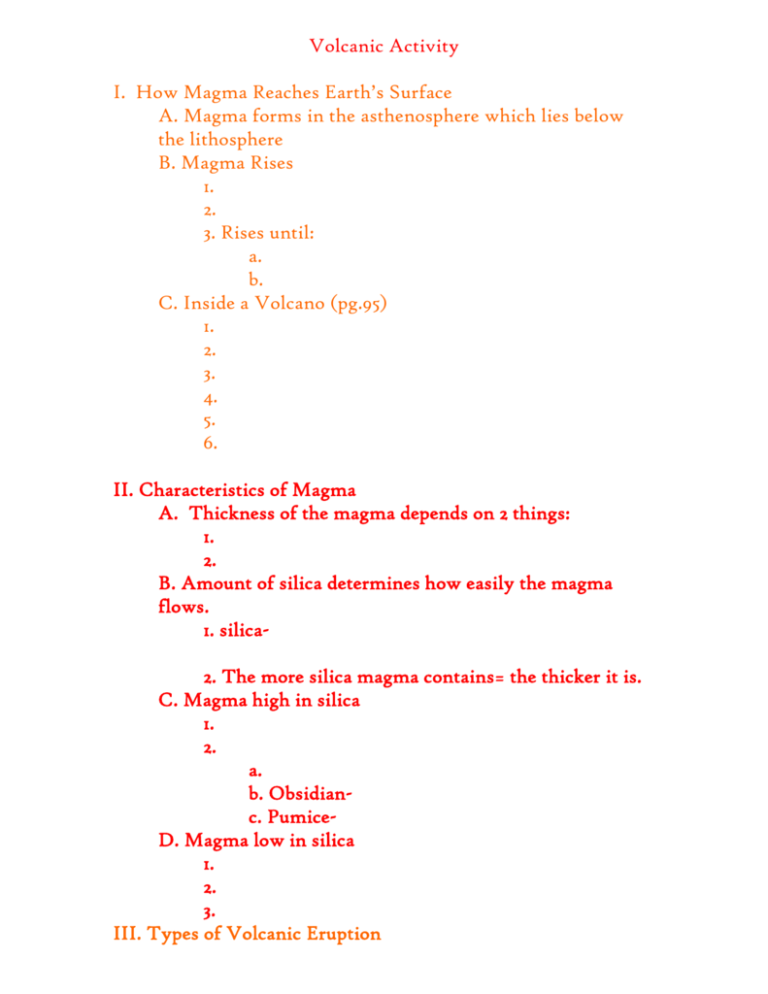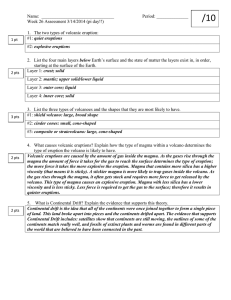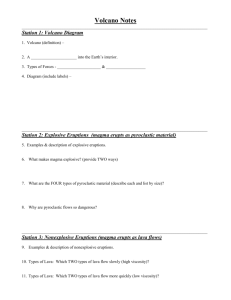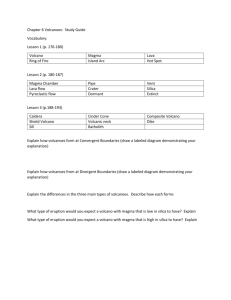Volcanic Activity - Epiphany Catholic School
advertisement

Volcanic Activity I. How Magma Reaches Earth’s Surface A. Magma forms in the asthenosphere which lies below the lithosphere B. Magma Rises 1. 2. 3. Rises until: a. b. C. Inside a Volcano (pg.95) 1. 2. 3. 4. 5. 6. II. Characteristics of Magma A. Thickness of the magma depends on 2 things: 1. 2. B. Amount of silica determines how easily the magma flows. 1. silica2. The more silica magma contains= the thicker it is. C. Magma high in silica 1. 2. a. b. Obsidianc. PumiceD. Magma low in silica 1. 2. 3. III. Types of Volcanic Eruption A. The silica content helps to determine whether the volcanic eruption is quiet or explosive. B. Quiet Eruptions 1. A volcano erupts quietly if: a. b. 2. Gas in the magma bubbles out gently 3. Example is Mount Kilauea 4. Produce 2 types of lava: (quiet eruptions) a. (1). (2). b. (1). (2). C. Explosive Eruptions 1. 2. 3. 4. 5. a. They quickly cool and harden into different size pieces (1.) smallest pieces-volcanic ash (2.) pebble-sized- cinders (3.) larger- bombs b. IV. Stages of a Volcano A. Activity may last from less than a decade to more than 10 million years. B. 3 Stages of volcanoes 1. active2. dormant 3. extinctV. Other types of Volcanic Activity A. Hot springs and geysers may occur in any volcanic area, even if it is extinct B. Hot Springs 1. 2. C. Geysers 1. 2. D. Geothermal energy 1. 2. VI. Monitoring Volcanoes A. Changes in and around the volcano usually give warning of an eruption B. Geologists use a variety of instruments to monitor changes: 1. tiltmeters 2. laser-ranging devices C. Detect surface changes caused by magma moving underground D. They also monitor 1. magnetic field 2. temperature of underground water 3. many small earthquakes that occur in the area around a volcano before it erupts E. They can still not be certain about the kind of eruption or how powerful it will be. VII. Volcano Hazards A. Although quiet eruptions and explosive eruptions involve different volcano hazards, both types of eruption can cause damage far from the crater’s rim. B. Quiet Eruption: lava flow pours from vents setting fire and then burying everything in its path C. Explosive Eruption: hot burning clouds of volcanic gases as well as cinders and bombs. D. Ash can: 1. bury entire towns 2. damage crops 3. clog car engines 4. When wet it can cause roofs to collapse. E. Eruptions can also cause 1. landslides 2. avalanches a. of mud b. melted snow c. rock










